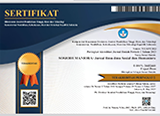IMPLEMENTATION OF THE SMART TOURISM STRATEGY FOR TOURISM DEVELOPMENT AT SINGKIL BEACH KARANG PAKIS NUSAWUNGU, CILACAP, CENTRAL JAVA
Abstract
Tourism development and management do not exclude the possibility of embracing the Fourth Industrial Revolution, including the use of information and communication technology to realize smart tourism. This is crucial because tourism development must adapt to technological advancements and innovations to provide the best service to tourists. This research employs a mixed-method approach that integrates quantitative and qualitative methods. Quantitative data is derived from statistical indicators of visits to understand the diversity of viewpoints and questionnaire responses from tourists. Qualitative data includes interviews with informants, observations, and research documentation processed through SWOT analysis to formulate strategies based on identified internal and external factors. The study found that the management of the Singkil Beach Karang Pakis tourist destination had not fully maximized its tourism potential. Therefore, a tourism destination development strategy is formulated based on the concepts of strengths-opportunities, weaknesses-opportunities, strengths-threats, and weaknesses-threats. The concept of smart tourism is applied through the implementation of smart experiences, destinations, and business ecosystems as part of the development strategy. By integrating information and communication technology, this concept promises innovation in tourist destination management. An increase in tourist visits, thereby enhancing the economic quality for stakeholders, such as Pokdarwis, tourism managers, and the local community marked the successful implementation of the smart tourism concept.
Keywords
Full Text:
PDFReferences
Alami, T., & Aria, T. T. (2016). Sustainable and smart destination management. Umeå School of Business and Economics.
Arifin, Z., Ariantini, M. S., Sudipa, I. G. I., Chaniago, R., Dwipayana, A. D., Adhicandra, I., Ariana, A. A. G. B., Yulianti, M. L., Rumata, N. A., & Alfiah, T. (2023). GREEN TECHNOLOGY: Penerapan Teknologi Ramah Lingkungan Berbagai Bidang. PT. Sonpedia Publishing Indonesia.
Bhakti, L. S. (2020). Status Eutrofikasi Berdasarkan Konsentrasi Klorofil-A, P Total, dan Kecerahan di Perairan Pesisir Cilacap. Universitas Jenderal Soedirman.
Blazevic, O. (2016). Health tourism and” smart specialisation”. UTMS Journal of Economics, 7(1), 85–95.
Buhalis, D., & Amaranggana, A. (2013). Smart tourism destinations. Information and Communication Technologies in Tourism 2014: Proceedings of the International Conference in Dublin, Ireland, January 21-24, 2014, 553–564.
Endi, F., & Prasetyo, D. (2020). Factors Influencing French Tourists to Visit Bali. TRJ Tourism Research Journal, 4(1), 25–44.
Fattah, V. (2023). EKONOMI PARIWISATA: Teori, Model, Konsep dan Strategi Pembangunan Pariwisata Berkelanjutan. Publica Indonesia Utama.
Gomes, E. L., Gândara, J. M., & Ivars-Baidal, J. A. (2017). Is it important to be a smart tourism destination? Public managers’ understanding of destinations in the state of Paraná1. Revista Brasileira de Pesquisa Em Turismo, 11, 503–536.
Gretzel, U., Sigala, M., Xiang, Z., & Koo, C. (2015). Smart tourism: Foundations and developments. Electronic Markets, 25, 179–188.
Harahap, M. N. (2021). Analisis Data Penelitian Kualitatif Menggunakan Model Miles dan Hauberman. MANHAJ-STAI UISU Pematangsiantar, 18(2), 2643–2653.
Hutagalung, S. S., & Hermawan, D. (2021). Analisis Partisipasi Masyarakat Dalam Pengembangan Objek Wisata Di Lampung Selatan. Sosiohumaniora, 23(1), 124. https://doi.org/10.24198/sosiohumaniora.v23i1.24698
Jasrotia, A., & Gangotia, A. (2018). Smart cities to smart tourism destinations: A review paper. Journal of Tourism Intelligence and Smartness, 1(1), 47–56.
Kagungan, D. (2020). Pelatihan Tata Kelola Destinasi Pariwisata Berbasis Media Branding Strategy (Membangun Kerjasama Kelembagan dan Peran Serta Masyarakat untuk Mewujudkan Desa Sungai Langka sebagai Desa Wisata). Jurnal Sumbangsih, 1(1), 141–148. https://doi.org/10.23960/jsh.v1i1.22
Kagungan, D., Zainal, A. G., & Rosalia, F. (2021). Genpi’S Strategy in the Development Digital Tourism Destination in Lampung Province. Sosiohumaniora, 23(2), 177–186. https://doi.org/10.24198/sosiohumaniora.v23i2.30912
Komariah, A., & Satori, D. (2013). Penelitian Kualitatif. Bandung: Alfabeta.
Kontogianni, A., & Alepis, E. (2020). Smart tourism: State of the art and literature review for the last six years. Array, 6, 100020.
Koo, C., Ricci, F., Cobanoglu, C., & Okumus, F. (2017). Special issue on smart, connected hospitality and tourism. Information Systems Frontiers, 19, 699–703.
Li, Y., Hu, C., Huang, C., & Duan, L. (2017). The concept of smart tourism in the context of tourism information services. Tourism Management, 58, 293–300.
Perdana, F. R. (2020). Aksebilitas Difabel Pada Objek Wisata Malioboro. JPI (Jurnal Pendidikan Inklusi), 4(1), 66–84.
Sigalat-Signes, E., Calvo-Palomares, R., Roig-Merino, B., & García-Adán, I. (2020). Transition towards a tourist innovation model: The smart tourism destination: Reality or territorial marketing? Journal of Innovation & Knowledge, 5(2), 96–104.
Silander, D., & Silander, C. (2018). The European Commission: The EU as agenda-setter for economic growth and entrepreneurship. In Governance and Political Entrepreneurship in Europe (pp. 57–81). Edward Elgar Publishing.
Sugandini, D., Nusanto, G., Ghofar, A., Arundati, R., & Purnama, R. F. (2022). Destinasi Wisata Cerdas (Pertama). Yogyakarta: Zahing Publishing.
Sugiyono, M. (2014). Penelitian Pendidikan Pendekatan Kuantitatif Kualitatif R&D cet. Ke-19, Bandung: Alfabeta.
Susetyarini, O. (2017). Kajian Manajemen Kunjungan Di Kawasan Wisata: Studi Kasus Destinasi Wisata Kaliurang. Jurnal Kepariwisataan, 11(2), 25–40.
Tüzünkan, D. (2017). The relationship between innovation and tourism: The case of smart tourism. International Journal of Applied Engineering Research, 12(23), 13861–13867.
Wardana, T. D., & Musadad, M. (2017). Pelaksanaan Bauran Promosi Objek Wisata Queen Star Waterpark Kabupaten Siak. Riau University.
Wetzel, E., & Barten, C. (2016). Smart Technologies in Tourism: Case Study on the Influence of iBeacons on Customer Experience during the 2015 SAIL Amsterdam Event. International Tourism Student Conference, April, 1–32.
Wimrayardi, Putra, I. E. D., Hidayat, H. A., & Parmadi, B. (2021). LOCAL CULTURE AS TOURISM ATTRACTION OF PAYAKUMBUH CITY. Humanus: Jurnal Ilmiah Ilmu-Ilmu Humaniora, 20(1), 111–123. https://doi.org/10.24036/humanus.v20i1.112562
Wyman, O. (2020). To recovery & beyond: The future of travel & tourism in the wake of COVID-19. World Travel & Tourism Council, Sept. https://wttc.org/Research/To-Recovery-Beyond
Ye, B. H., Ye, H., & Law, R. (2020). Systematic review of smart tourism research. Sustainability, 12(8), 3401.
DOI: https://doi.org/10.24198/sosiohumaniora.v26i1.36908
Refbacks
- There are currently no refbacks.
Copyright (c) 2024 Sosiohumaniora

This work is licensed under a Creative Commons Attribution-ShareAlike 4.0 International License.
Sosiohumaniora Indexed By:
 Creation is distributed below Creative Commons Attribution-ShareAlike 4.0 International License.
Creation is distributed below Creative Commons Attribution-ShareAlike 4.0 International License.
Published By:
Faculty of Social and Political Sciences, Universitas Padjadjaran
Dean's Building 2nd Floor, Jalan Ir. Soekarno Km. 21 Jatinangor, Sumedang 45363
Email: jurnal.sosiohumaniorafisip@gmail.com
















